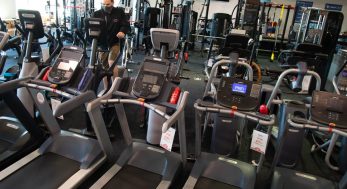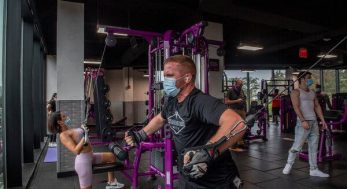
WASHINGTON – A petite woman in a bright pink shirt jumped up and grasped a pull-up bar in a suburban park. She shifted her grip. Then she began to knock out pull-ups – one, two, three. Onlookers burst out in applause, cheering her on. They had gathered on a cool Saturday morning to learn how to use the new gym at the 38th Avenue Neighborhood Park in Hyattsville, Maryland.
“It’s great to see people out and being active,” said Sam Orah, a fitness trainer. He walked the crowd of about 13 through a circuit workout, showing them how to use suspension rings, plyo boxes (for jumping on and off) and pull-up bars. “We need one of these in every city.”
The sleek blue-and-silver setup is the latest version of what the San Francisco-based National Fitness Campaign calls a fitness court. The free-to-use facilities are one way that communities such as Hyattsville are helping their citizens squat, push-up and lunge toward healthier living.
The NFC is a public-private partnership that was founded by developer and fitness enthusiast Mitch Menaged in 1979 to fill a need for “healthy infrastructure,” according to its director of partnerships, Trent Matthias. The original fitness courts were wooden structures with such features as pull-up bars and benches; the organization helped install more than 10,000 of them in about 4,000 communities in the United States, Canada and Australia over roughly three decades. After Menaged decided to modernize the setup, the NFC began to redesign the courts in 2012. The rollout across the country began last year, and Matthias expects to have more than 100 of the new courts open by the end of this year.
Each new 32- by 35-square-foot court is made of 30 pieces of weather-resistant equipment divided into seven stations. At each station, users can focus on one area – core, squatting, pushing, lunging, pulling, agility and bending – by performing such body-weight exercises as box jumps, lunges or sit-ups. A full circuit takes about seven minutes.
Acquiring a court is a process that can take eight or nine months. Communities submit an application online, and NFC staff works with applicants to analyze locations where the court would create the most impact, such as an undeveloped field along a park trail or a tennis court that has seen better days. “It really depends on the community and what’s available,” Matthias said. Installing a court takes about a month.
Officials in Maryland Heights, Missouri, a suburb of St. Louis, thought a fitness court would be the ideal use for a tiny plot of land – less than half an acre – where nothing else could really go. “There is no other amenity like it on that side of town,” said Tracey Anderson, the city’s director of parks and recreation.

The city also installed a light so the facility could be used at night, and the court has become a popular workout spot since it opened about a year ago. “There’s always people there,” Anderson said. It’s become such a hit that council members have even asked if they can install another one on the city’s east side, she said.
In an era when there’s an app for nearly everything, the free Fitness Court app (available on Android and iOS) teaches users to create a circuit workout on their own. “There can be a mind-set of ‘I don’t know how to use it, so I’m not going to,’ ” Anderson said. “But what’s great is that you can tell people, ‘There’s an app! You have a smartphone; you can learn how.’ ”
Colleges are also getting on board: Stanford University in California and Baylor University in Waco, Texas, are among the campuses that have installed courts. An expansion to high schools is in the works. “We’re developing programs for teens to get involved in a constructive way outdoors,” Matthias said. (Fitness courts are designed for ages 14 and up, he said; national regulations determine the minimum age.)
The NFC’s renewed push comes as obesity in the United States continues to rise, even as adults are exercising more, according to data from the Centers of Disease Control and Prevention. And the NFC’s efforts don’t stop at the installation of a fitness court. “We want to create impact long after it’s been put in the ground,” Matthias said.
To do that, community involvement is essential, and municipalities are exploring different ways to create partnerships to promote well-being centered on the outdoor gyms. In Loveland, Colo., UCHealth, a local health system, conducts classes at the city’s fitness court, featuring such topics as healthy eating for seniors. “There’s just something about it, to breathe in the fresh air and see the mountains,” said LeAnn Williams, the city’s recreation manager, about the court. “It’s a better experience.”
The NFC also launched an “ambassador” program this year that allows fitness instructors, as well as public safety officials such as firefighters, to apply to teach free classes on-site. Loveland’s recreation department has built up a strong squad of ambassadors since its court opened in June, Williams said. Instructors from their recreation center have been holding introductory workouts and boot camps on-site three to four times a week. “It’s a neat way to connect the community,” Williams said. “It’s different.”
A court can also translate to savings for residents, because using it is free: If Loveland residents don’t want to pay for memberships (or $5.25 for a drop-in class) at the city’s recreation center, they can sign up for a free class at the court, weather permitting. With classes at the recreation center booked to capacity, Williams said, the fitness court offers a welcome alternative and has been “well worth our investment.”
The cost of a fitness court varies, depending on how the chosen location needs to be developed. The NFC offers grants to jurisdictions funded by corporate sponsors, and money is awarded on a rolling basis annually.
Hyattsville received about $10,000 toward the cost of its facility. The city paid the rest of the bill, about $100,000, according to city spokesman Jake Rollow. Maryland Heights also received a grant of about $10,000 and spent at least $80,000 more to develop the property, spokeswoman Trisha Hall said. Loveland received a grant of $30,000 and split the remaining $123,000 cost 60/40 with UCHealth, said Molly Elder, the business manager for the parks department.
In Hyattsville, there has been a lot of support for the project, said Lesley Riddle, the city’s director of public works and one of several officials on hand Saturday to introduce residents to the fitness court. Mayor Candace Hollingsworth “has a lot of passion for bringing accessibility for health and wellness and exercise,” Riddle said. “We took that and ran with it.”
Plans to install a shade cloth over the structure are in the works, Riddle said, and the city is hoping to add WiFi there as well. The court’s app comes with the potential for communities to gather user statistics and other data, but Hyattsville currently doesn’t plan to do so, Rollow said. “We just want to see folks use it and enjoy it,” he said.
The court opened earlier this summer and has already seen plenty of use. “If you build it, they will come,” Riddle said.
Carole Plato, 57, rode her bike over to check out the fitness court, which is next to a trail, making it convenient for runners and cyclists. “We’re really lucky to have this,” she said after finishing the orientation workout. “And it’s free!”
Subscribe to our weekly newsletter to get outdoors news sent straight to your inbox.


